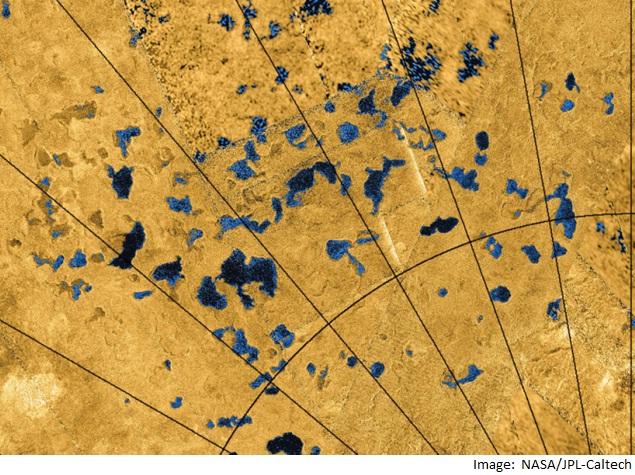- Home
- Science
- Science News
- Cassini Probe Finds 'Lakes' on Saturn's Moon Titan
Cassini Probe Finds 'Lakes' on Saturn's Moon Titan

Apart from the Earth, Titan is the only body in the solar system known to possess surface lakes and seas, which have been observed by the Cassini spacecraft.
The team calculated how long it would take for patches of Titan's surface to dissolve to create these features.
"We compared the erosion rates of organics in liquid hydrocarbons on Titan with those of carbonate and evaporite minerals in liquid water on Earth," said Thomas Cornet of the European Space Agency.
"We found that the dissolution process occurs on Titan some 30 times slower than on Earth due to the longer length of Titan's year and the fact it only rains during Titan summer. Nonetheless, we believe that dissolution is a major cause of landscape evolution on Titan and could be the origin of its lakes," Cornet said.
These are terrestrial landscapes that result from erosion of dissolvable rocks such as limestone and gypsum, in groundwater and rainfall percolating through rocks.
Over time, this leads to features like sinkholes and caves in humid climates and salt-pans where the climate is more arid.
The rate of erosion creating such features depends on factors such as the chemistry of the rocks, the rainfall rate and the surface temperature.
While all of these aspects clearly differ between Titan and Earth, the researchers think the underlying process may be surprisingly similar.
"By comparing Titan's surface features with examples on the Earth and applying a few simple calculations, we have found similar land-shaping processes that could be operating under very different climate and chemical regimes," said Nicolas Altobelli, ESA's Cassini project scientist.
Catch the latest from the Consumer Electronics Show on Gadgets 360, at our CES 2026 hub.
Related Stories
- Samsung Galaxy Unpacked 2025
- ChatGPT
- Redmi Note 14 Pro+
- iPhone 16
- Apple Vision Pro
- Oneplus 12
- OnePlus Nord CE 3 Lite 5G
- iPhone 13
- Xiaomi 14 Pro
- Oppo Find N3
- Tecno Spark Go (2023)
- Realme V30
- Best Phones Under 25000
- Samsung Galaxy S24 Series
- Cryptocurrency
- iQoo 12
- Samsung Galaxy S24 Ultra
- Giottus
- Samsung Galaxy Z Flip 5
- Apple 'Scary Fast'
- Housefull 5
- GoPro Hero 12 Black Review
- Invincible Season 2
- JioGlass
- HD Ready TV
- Laptop Under 50000
- Smartwatch Under 10000
- Latest Mobile Phones
- Compare Phones
- OPPO Reno 15 Pro Max
- Honor Win RT
- Honor Win
- Xiaomi 17 Ultra Leica Edition
- Xiaomi 17 Ultra
- Huawei Nova 15
- Huawei Nova 15 Pro
- Huawei Nova 15 Ultra
- Asus ProArt P16
- MacBook Pro 14-inch (M5, 2025)
- OPPO Pad Air 5
- Huawei MatePad 11.5 (2026)
- Xiaomi Watch 5
- Huawei Watch 10th Anniversary Edition
- Acerpure Nitro Z Series 100-inch QLED TV
- Samsung 43 Inch LED Ultra HD (4K) Smart TV (UA43UE81AFULXL)
- Asus ROG Ally
- Nintendo Switch Lite
- Haier 1.6 Ton 5 Star Inverter Split AC (HSU19G-MZAID5BN-INV)
- Haier 1.6 Ton 5 Star Inverter Split AC (HSU19G-MZAIM5BN-INV)

















